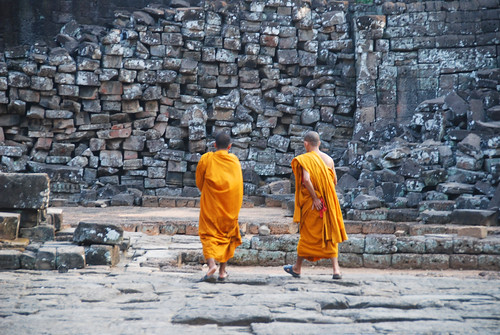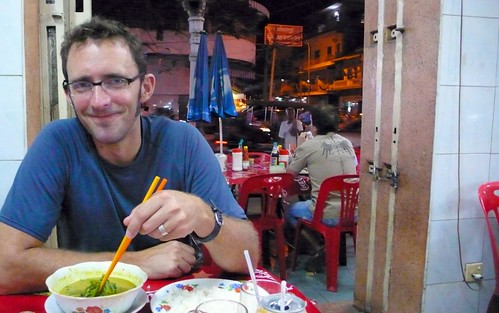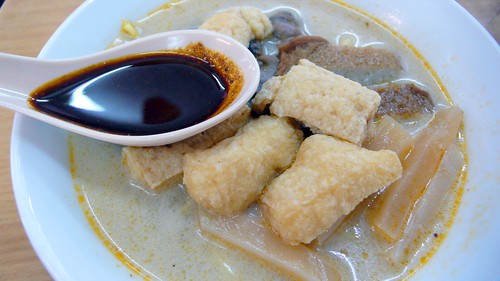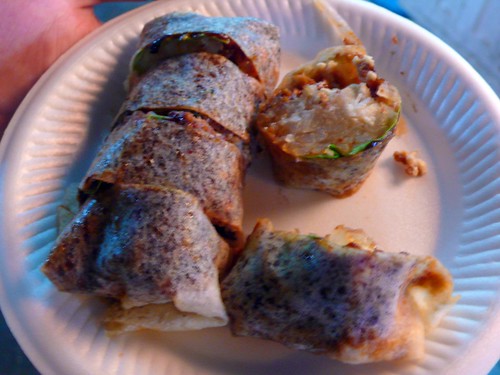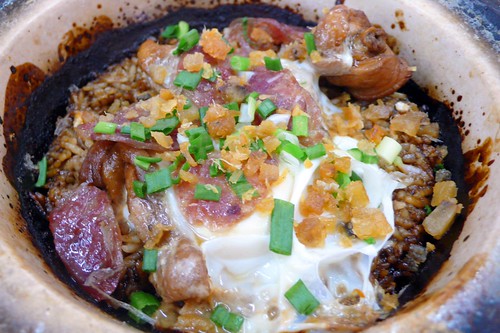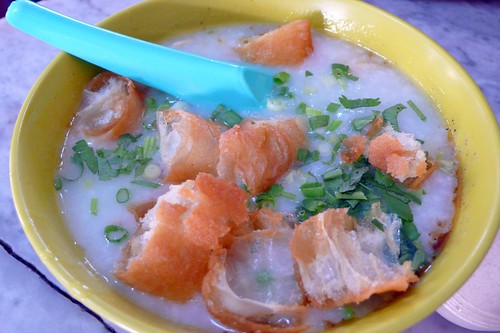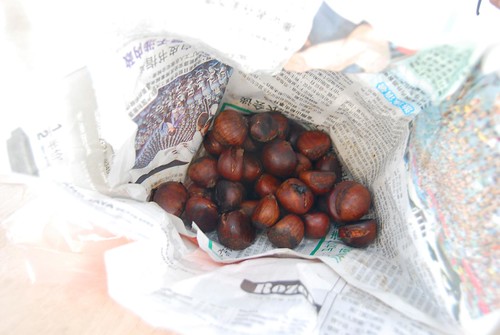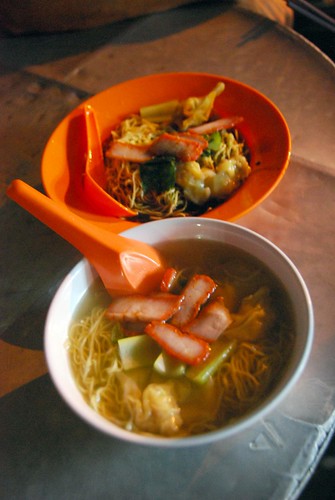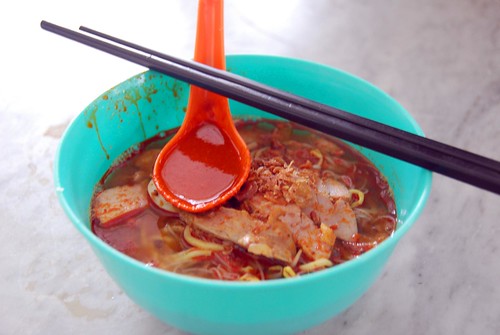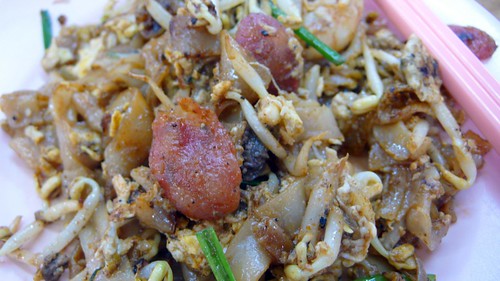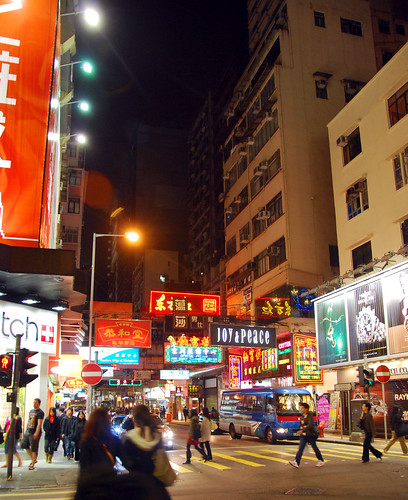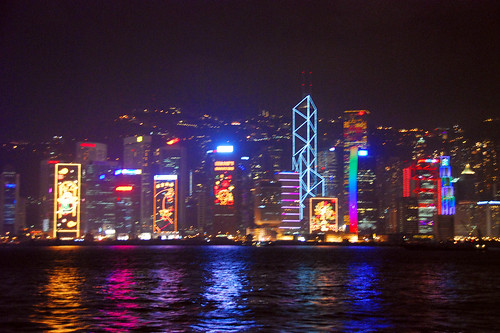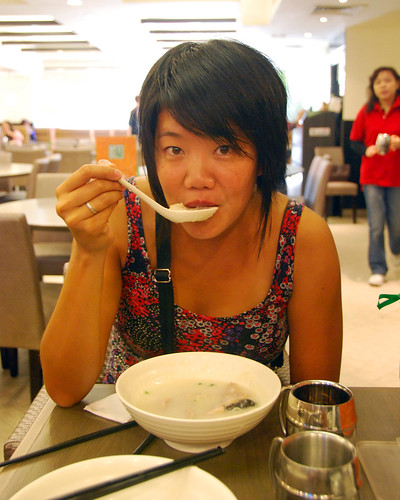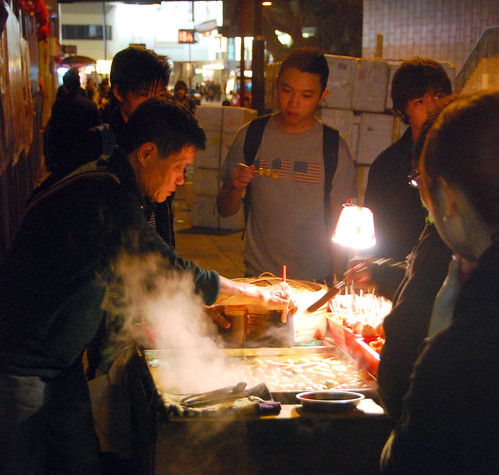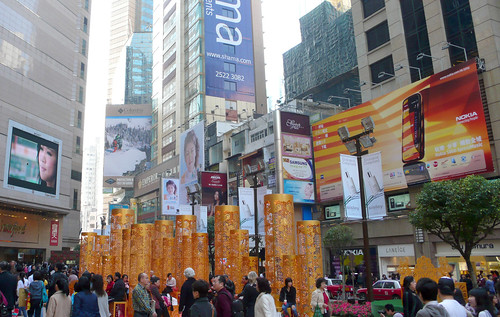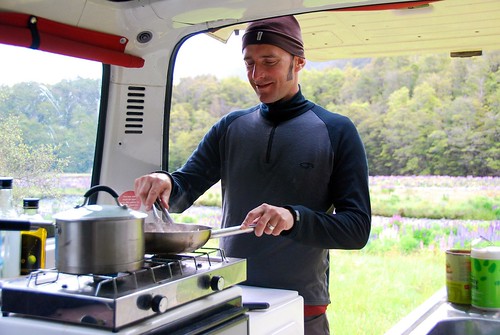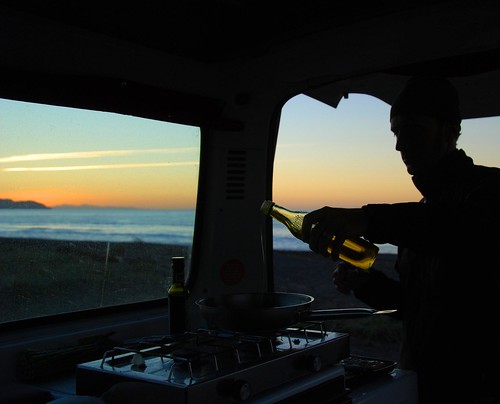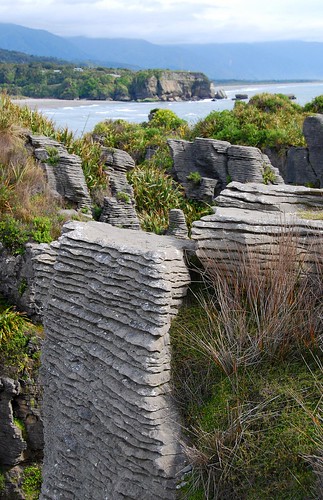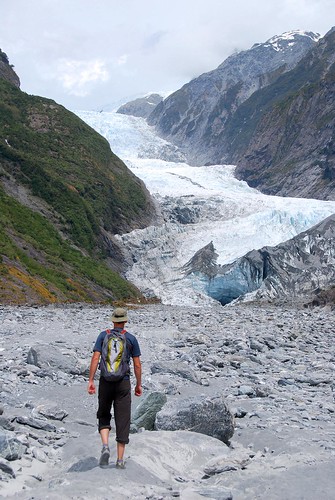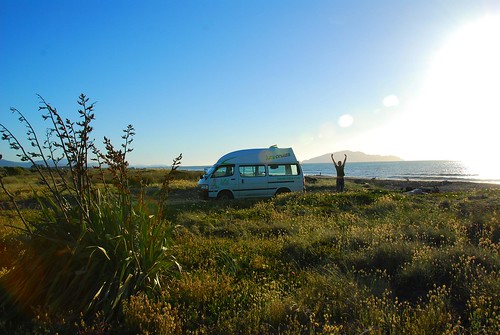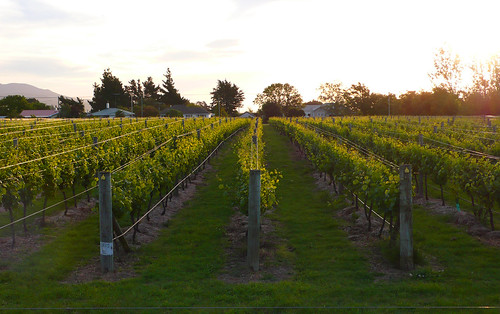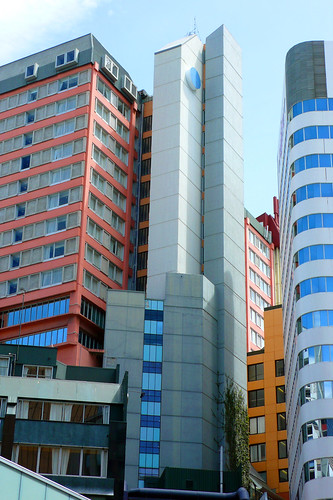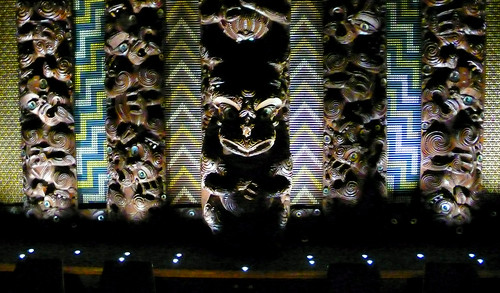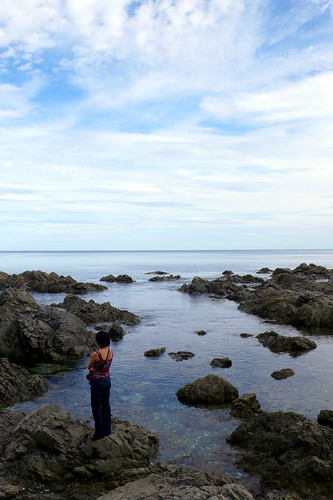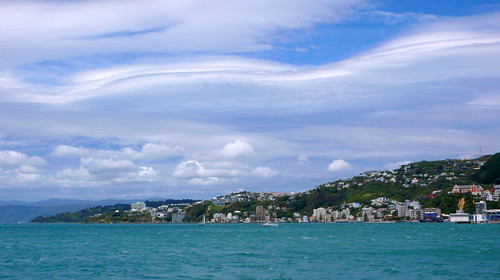Posts Tagged ‘food’
Note: If you’re wondering why we did not do wrap-ups for Thailand and Malaysia yet, it’s because we are planning on returning to both countries towards the end of our SE Asia tour.
Days spent here: 7 (February 6-12, 2009)
Prices: We’ve heard a lot of backpackers complain that Cambodia was expensive relative to the rest of SE Asia, and we agree, though we didn’t feel it was outrageously so. In Siem Reap, our hotel (Mandalay Inn) was one of the nicest we stayed in, and one of the cheapest. However, food was on the pricey side (US$3-8 for mains) and the pass to visit Temples of Angkor was definitely expensive (US$40 for a 3-day pass), plus it costs an additional US$12 to hire a tuk-tuk driver to take you into the park (for a full day). In Phnom Penh, our accommodation was moderately priced but not that nice (we paid US$14 for a room without a window)…we got less for our money here. Food was on the spendy side as well.
Places we visited: Siem Reap and the Temples of Angkor, Phnom Penh.
Places we would happily visit again: We LOVED the town of Siem Reap, and the temples just speak for themselves. Even beyond the majesty of Angkor Wat, the town itself was really charming and the people were so nice. Phnom Penh, on the other hand, did not share the same charm; it was sort of a generic SE Asian capital city (in our limited experience of it), and there were a lot of Western tourists, which created a limited set of interactions between foreigners and the local people.
Places we want to see next time: Kratie, where you can see river dolphins, and Sihanoukville, the one big Cambodian beach destination.
Food: Khmer food is good! It has the richness of Thai food but the freshness of Vietnamese food. We sort of tired of it by the end of our visit, but we basically ate Khmer dishes for an entire week so I don’t think that reflects badly on the food. The one standout dish was “green soup” (not terribly descriptive, but that’s what the menu called it), which we had at a food stall in Phnom Penh.
Dust: It’s freakin’ dusty in Siem Reap! When you’re in the back of a tuk-tuk on the way to the temples, do as the locals do and tie a checkered Cambodian scarf around your face to keep out the dust and exhaust. You can buy these for about US$1 at the local markets.
Cambodia wins the “most family members on a motorbike award”: It is VERY common to see an entire family of four or five on a motorbike in Cambodia. The typical configuration is this: oldest child (usually a toddler) in between the driver’s (usually Dad’s) legs, second oldest child wedged between Mom and Dad, and a baby in Mom’s arms. These people grow up on motorbikes so they are very comfortable with the arrangement, though it is very shocking to us safety-conscious Americans.
Check out our Cambodia Flickr album
As I mentioned in a previous post, we came to Malaysia because we tried Penang and Mussaman curries in Thailand and loved them. Well, we found out much later that these are not Malaysian curries at all, but Southern Thai curries. So, our entire reason for visiting Malaysia was based on a misunderstanding. No matter, because we loved the food in Penang even more than the curries that brought us here.
Penang is known throughout SE Asia for its amazing food. This owes a lot to the clash of cultures that exists here…Indian spices, Chinese noodles, and Thai herbs flow freely into the Malay dishes. Plus, the food is cheap! We had only 1 restaurant meal the 4 days we stayed here, and ate at food stalls the rest of the time, with our dishes costing between 2 and 5 ringgit (aprox. US$0.50 to US$1.50). Even better, the portions here are small, so we could eat about 6 meals a day (splitting the dish each time, so we weren’t really THAT gluttonous). After losing a few pounds in Thailand from our stomach flu, we could afford to overeat a bit anyway. ![]()
Food stand eating is quite convenient in Penang. Not only is it fast and cheap, but there are usually small plastic tables set up nearby so you can actually eat your meal at a table. Basically, it’s just like eating at an open-air restaurant.
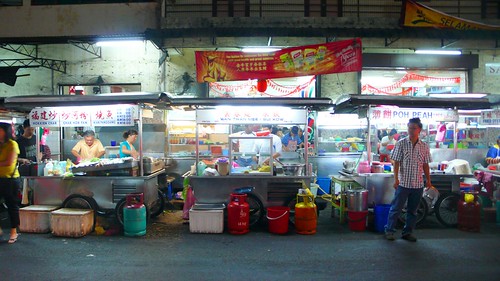
At the New Lane hawker center.
Below is a selection of dishes that we really enjoyed.
Curry Mee (Malaysian)
Curry mee is a noodle soup with a coconut milk base. This was by far our favorite dish in Penang—so nice we ordered it twice! Interestingly, in Penang, noodle soups are often made with both egg and rice noodles—two great tastes that taste great together. Curry mee also includes fried tofu, bamboo shoots, cubes of pig’s blood (thankfully, we did not know what this was until later…we tried it and didn’t mind it), and snails (didn’t know what this was either when we ate curry mee…tried one, didn’t like it). It is served with a spoonful of hot sauce on top; you drop the spoon in and mix the hot sauce with the curry broth. It is really spicy and rich and delicious. My mouth is watering just writing this.
Popiah (Malaysian)
This is a small roll filled with some sort of brown sauce (maybe hoisin?), lots of shredded yam bean, dried bean curd, and some sort of meat (we read that it was crab meat, but we think ours was filled with chicken). All of this is wrapped in a fresh spring roll skin. Because of the yam bean, this roll is super juicy, not dry like most spring rolls. It is absolutely incredible…we were shocked by how tasty and delicious it was, especially since it doesn’t really look like much on the plate. ![]()
Chicken Rice
Again, another winner. This is simply roasted chicken (sometimes they sell it with boiled chicken—be sure to find a stall that sells roasted chicken since it is much, much tastier) with bean sprouts and green onion served with a scoop of rice, a small bowl of chicken broth, and an amazingly delicious chili sauce with ginger. Mix all of these elements together, and you get one of the best meals we had in Penang. Sounds simple, but the flavors are each so distinct that it makes this dish a standout.
Claypot Chicken Rice
This dish is quite different from regular chicken rice. The claypot is placed on top of the range, with a scoop of rice and a dark brown liquid (we think it is a very light soy sauce mixed with other goodies) thrown in. It also includes chinese sausage, stewed chicken, and an egg. This dish sounds like it might be heavy (due to the soy sauce mixture that the rice is cooked in), but it surprisingly light. Also, the crispy rice at the bottom of the pot is a delicious treat.
Nasi Kandar (Indian)
Nasi kandar is a generic term for “Indian stuff with rice.” You can choose any number of curries, fried treats, roasted meats or veggies to go with your rice. They sell it everywhere in Penang and you could probably eat nasi kandar at every meal and never have the same thing twice. We actually had this dish in the ferry building in Langkawi. It is chicken masala, curried rice, and cucumber and pineapple salad.
Congee/Jook (Chinese)
Congee or jook is Chinese rice porridge, and I grew up eating it on the weekends for breakfast. I used to eat it plain with sugar, but in my adulthood I have come to enjoy salty jook. Jeremy loves this stuff too, maybe even more than I do. In Penang, we had it with salted and preserved eggs and chinese fried dough. We will be eating a lot of this when we get to Taiwan. Stay tuned. ![]()
Roasted Chestnuts
There are two roasted chestnut vendors at the Chowrasta market off of Jalan Penang. I remember when I was a kid my dad used to make roasted chestnuts and I always loved them. They are mildly sweet and make a great snack.
Char Siew Noodle Soup and Stir-fried Noodles
We happened upon this food stall one night and had a quick and simple dinner. It’s just a simple noodle soup with barbecued pork and veggies on top. The stir-fried noodles have some soy sauce mixture poured over them. It’s really yummy.
Roti Cenai (Indian)
Unfortunately, I guess I forgot to take a picture of this dish. It is an Indian bread fried in ghee that can come stuffed with goodies like egg and onion. You get a curry dipping sauce with it and it is greasy and delicious.
Sugar Cane Juice
Not a meal, but worth mentioning anyway. You can all kinds of fresh-squeezed juices in Penang (we also really liked the starfruit juice). If you take it “to go,” they dump it in a bag with some ice—no plastic cups here.
Not every meal we had was insanely good. There were a few dishes we tried that we didn’t love. Here are some of those meals:
Hokkien Mee
Hokkien mee is a spicy noodle soup with prawns and Chinese cabbage. We didn’t love this dish because it is very fishy tasting, even for us (we love fish). We think the broth is made with dried shrimp, which gives it a very strong, almost smoky flavor.
Char Kway Teow
This is basically a stir-fried noodle dish with flat rice noodles, chinese sausage, bean sprout, and egg. It was fine, but not one of the standouts. Maybe if I tried one of the other char kway teow vendors?
Assam Laksa
Sorry, again, no photo. We may have ordered this from the wrong place…we got it from a Muslim hawker stand because they were the only ones not harassing us to eat at their joint. Laksa is not a Muslim dish, however (it’s Malaysian), so it may be better at another food stand. Also, it’s worth noting that laksa in Penang is different than laksa elsewhere in Malaysia—the broth is much fishier and there is less coconut milk used.
We want to give a special shout-out to the people running the food stands. These people are amazing! They are super fast, they work long hours, and they often speak several different languages. We should have gotten video of some of these people working…their hands move so fast, they look like martial artists! Hi-ya!
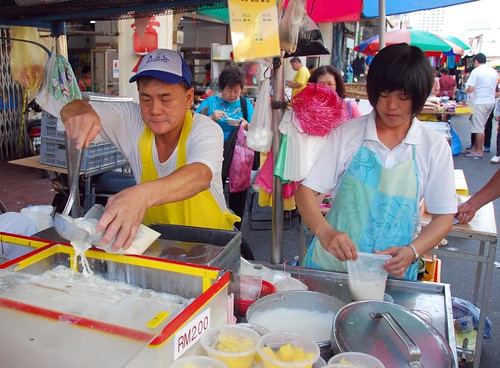
Soy milk vendor at Chowrasta market.
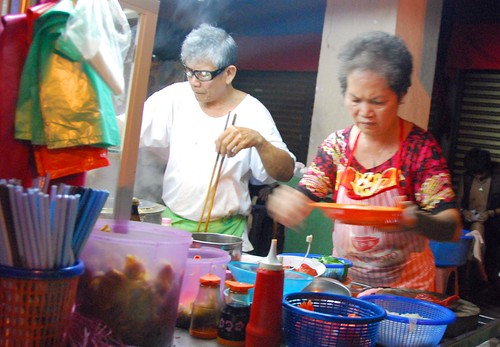
Char siew noodle soup stall on Lebuh Chulia.
As you can probably tell, we loved Penang. The food is great, we love the mix of different cultures all living together peacefully, and best of all, there are not that many tourists here as compared to other parts of SE Asia. We had a nice time climbing and swimming in southern Thailand, but we were troubled by how much it seemed like a playground for Europeans and Americans. We were longing for a little more interaction with the locals and we got that in Penang. Malaysia rocks!
We’re about two months into our trip now, and from here on out, the only English-speaking country we will visit is Ireland. We’re headed to Asia—southeast Asia, to be exact…the land of squat toilets, cold showers, mosquito nets, and delicious food. But first…we spent one night in Hong Kong on our way to Thailand, and though 24 hours doesn’t seem like a very long time, it felt like we managed to do quite a bit during our short stay there (we plan on staying a little longer when we fly back through Hong Kong on our way from SE Asia to Taiwan).
We flew from Cairns to Hong Kong on our around-the-world ticket, and then purchased tickets from Hong Kong to Bangkok via AirAsia (http://www.airasia.com), a low-cost Asian airline. It cost us about HKD$2100 (approx. US$300) each for the roundtrip tickets. This is a little more expensive than we expected it to be, but it was the best deal we could find.
We booked a great room at the Mingle Techotel via wotif.com (a GREAT last-minute hotel resource that Jasmine told us about) in the Tsim Sha Tsui district of Kowloon. Random funny: I thought we booked a room at the Mingle “Tee-cho-tel”. It took me a minute to realize it was actually a “tech hotel,” not some weird Mayan hotel in the middle of Hong Kong.
We got in a bit late—it was about 10PM by the time we took the train into Kowloon and then the taxi to our hotel, but the place was absolutely alive like it was a Friday night (it was Tuesday). The streets were packed with people shopping (the stores don’t close until about 11PM here), eating at the food stalls, and generally hanging out with friends.
We walked around Tsim Sha Tsui and headed towards the boardwalk, where you can see Hong Kong across Victoria Harbour.
We were pretty exhausted from our long flight and headed back to the hotel after an hour or so. But when we laid down and turned on the TV, what was on but the inauguration! We had to stay up and see our new president get sworn into office. So, right there in our Hong Kong hotel room, we watched as Barack Obama took the presidential oath. It’s a strange thing traveling as Americans during this time…Jeremy and I have been to South and Central America, Asia, and Europe before, but this is the first time as travelers that we feel proud to be Americans. Everywhere we have been, people have been very supportive of Obama. We felt really patriotic watching the inauguration, thinking that we were sharing this moment with millions of people, not just in the US, but around the world. It was 1:30AM Hong Kong time when Obama finally finished his speech, but it was worth the wait. ![]()
The next morning, rested and reassured that things were getting kicked off back home, we enjoyed a great breakfast—I had jook (they call it congee here) with pork and pickles, Jeremy had wonton soup. Yum!
Jeremy and I split up for the day—he wanted to see if he could exchange his North Face day pack (which is already falling apart after 2 months), and I wanted to go shopping (it’s official, I am sick of my clothes). Hong Kong is a shopping haven…in fact, I’m not sure what else people do in Hong Kong! It seems like people are just buying things all day long. So, I headed towards Mong Kok, while Jeremy took the subway into Hong Kong.
I found a street market with lots of clothing stalls and found a few cute items. Of course, I had to bust out the Mandarin when negotiating (even though most people speak Cantonese in HK)—I figured that speaking English can only end in a higher price. I may have gotten totally robbed, but both the saleslady and I were happy with the deal so that’s a good bargaining session in my book.
I also had a chance to sample some of the Hong Kong street food while I was out and about. Some of it was a little scary-looking (fish balls stewing in a curry sauce?), but I was able to point at some delicious deep-fried dumplings and some pork meatballs on a stick. Yum!
Jeremy had a good day downtown too, though we were both pretty exhausted after our day on the town. The sheer number of people in this city makes simply walking the streets a huge effort. This is good practice for the rest of Asia, though…at least there are sidewalks in Hong Kong!
Thanks for the great day, Hong Kong! We’ll see you soon…
To help keep costs down and because we love cooking (and eating!), we prepared as many of our own meals as possible while traveling around New Zealand and Australia in our camper vans. It turned out to be a great decision, as the meat and produce were fresh and delicious almost everywhere we stopped and many of the smaller towns didn’t have appealing (or in some cases, any) restaurants. For the price of a mediocre meal out, we could prepare something more extravagant ourselves.

Rack of lamb, cucumber salad, and green salad
Our favorite meals revolved around the great meat and produce that both countries had to offer. In both New Zealand and Australia, the beef and lamb appears to be grass fed by default. There is plenty of pastureland and no subsidized corn industry, so the the sheep and cows spend their days in the gorgeous open pastures munching on grass. Happy grass fed animals made yummy meat. (Interestingly, we did just notice a restaurant in Sydney that advertised “grain fed rump steak”. Apparently some prefer the fatty taste of grain fed beef. Not us!)
It did take a little while to figure out and get used to the way that meat is butchered down here. The most common cut of beef is the “Scotch fillet,” which we eventually figured out is the same as an American “ribeye”, although it tends to be cut thinner. We preferred the Porterhouse steaks because because they have less marbled fat and gristle, and were able to find them most places except for the really small towns.
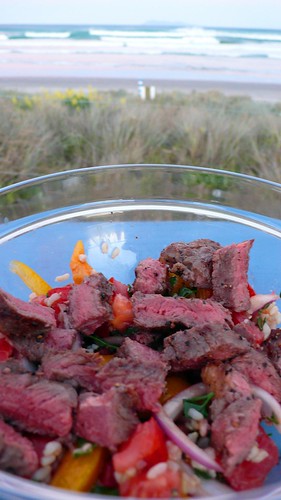
Brown rice and steak salad at the beach.
We tried a few different cuts of lamb, but rack is far and away the best (and most expensive). The loin chops were quite good too, but they tended to have a lot of bone and fat so are a little more difficult to deal with. We tried the leg chops once and didn’t like it as much: tougher meat with more fat and connective tissue makes the leg a better candidate for roasting or braising.
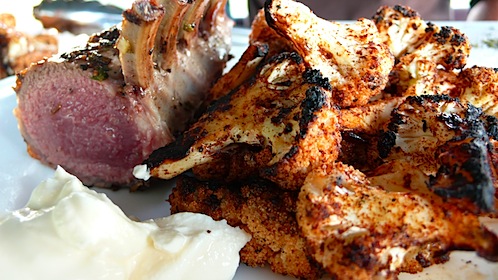
Rack of lamb with roasted cauliflower.
It was more difficult to find cuts of pork that we liked; but when we did they were always great. The Kiwis, at least, seem to prefer loin chops with lots of bone, fat and skin. Yes, they leave the skin on the meat (”with rind”)! Maybe the skin fries up nicely, but it made us squeamish and we always cut it off. Not surprisingly, we loved the bacon, and in New Zealand the bacon section in the market was often as big and varied as the sections for lamb and beef.

Pork chops, mushrooms and peppers, green salad.
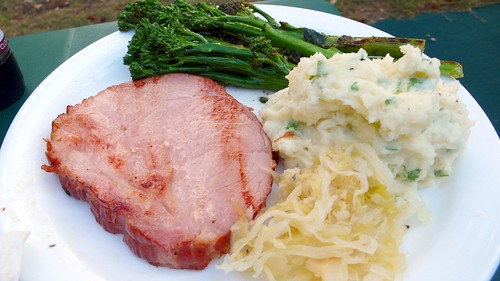
Christmas dinner: fried ham, mashed potatoes, sauerkraut, and broccolini.
Although we ate less seafood, the Atlantic Salmon (farmed raised in New Zealand and Tasmania) and the green lipped mussels from New Zealand were really yummy.
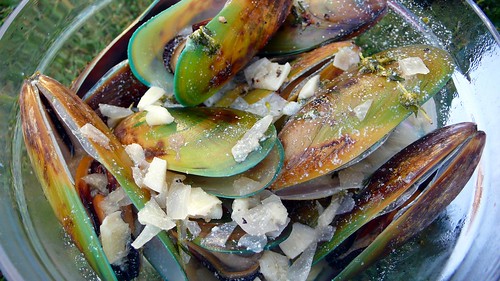
New Zealand green lipped mussels in a white whine and garlic cream sauce.

Pan-fried Salmon with paprika, green salad, and broccolini.
Most places we stopped had great produce, although it was expensive at times and there was typically less variety than in the US (probably because it was all local rather than shipped in from around the world). Avocados, onions, cucumbers, green beans, asparagus, broccoli and broccolini, cauliflower, and lettuce were all very good. We were surprised at how was difficult to find good garlic: it all seemed to be imported from China and was often old and sprouting. Whenever possible, we stopped at some of the local farms or veggie stands for our produce, as the prices were lower and the selection fresher.
In New Zealand, there was some very good (but also very expensive) cheese. Apparently, parts of Asia are developing a taste for cheese and as a result it has become a big New Zealand export, and to the dismay of the Kiwis, this is driving up the price at home. (I think I heard that the price has tripled in the last few years). The eggs in New Zealand are also amazing…the yolks are a bright orange color and they are super fresh and delicious.
Both of the vans that we rented came equipped with stove, fridge, sink, pots and pans and utensils. It was actually quite liberating to cook and eat with one pan, two plates, two forks, and two cups (Hope’s comment: especially for Jeremy, the “use-every-utensil-in-the-kitchen” type of chef!). We became masters of the “one pot” meals. All holiday parks in New Zealand come equipped with a fully-stocked kitchen, though this is not the case in Australia. Typically, Aussie “caravan parks” only have a barbie (though their barbecues are simply large outdoor metal pans with a hole in the center for drainage). Even in New Zealand, we preferred to cook over our little propane stove, as our camp views were typically much nicer that the inside of a kitchen. ![]()
The fridge and storage space were limited in the van, so we shopped every day at times. We bought a few staples to stock our pantry, but overall tried to keep things simple.
- Sea salt flakes
- Black pepper grinder
- Olive oil
- Red wine vinegar
- Red pepper flakes
- Smoked paprika
- Fresh rosemary and thyme
- Garlic
Thanksgiving at Four Rivers
When we finished our tramp through the hills above the Nelson Lakes, we packed up the van and followed the river towards the West coast for a few hours and found a holiday park near Murchison to camp for the night. Surprise, surprise…another gorgeous camp with a cafe overlooking the river.
We shared the camp with a group of teenagers from the US and Canada who are part of a “Kayak Academy”. They travel around the world (or at least New Zealand and Chile) with their instructors/coaches, do schoolwork in the morning, and kayak in the afternoon. Not a bad life, if you ask me—and gives me some ideas for how to get more involved with our kids’ education. I tried (but probably failed) to impress one of them with stories of growing up kayaking in Idaho. Sheesh, kids these days…
We Skyped Hope’s parents from the van to wish them a happy Thanksgiving and then got to work preparing our own celebratory meal. They don’t seem to have turkey in New Zealand, so we had to settle for pan-fried lamb chops with fresh thyme, rosemary, and garlic and a cucumber salad with feta cheese. We didn’t miss the bird.
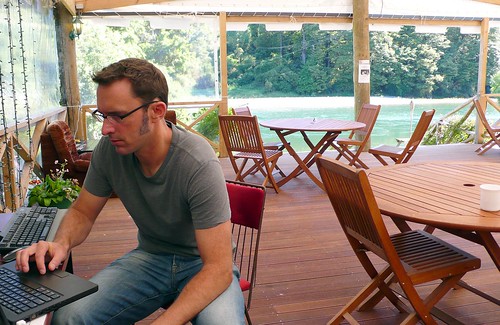
Getting ready to Skype Jeremy’s parents from the cafe at the Murchison Holiday Park.
Westport and Cape Foulwind
The next morning, we headed west towards the coast. We stopped at the Bay Cafe in Tauranga Bay (one of the recommended stops on Bob’s Tour) and had a delicious curried seafood chowder and some fresh baked garlic bread.
Pancake Rocks (at Punakaiki)
On the way down the coast, we stopped for an hour at Pancake Rocks, an area where layered limestone has been exposed and carved away into intricate shapes by the waves. At high tide, there are blowholes that funnel the crashing waves into water spouts. Apparently, geologists don’t understand how the unusual layered limestone was formed, but they sure look cool. The New Zealand park service did an excellent job providing access to the site: the trail was lined and camouflaged with limestone bricks meanders through the rock formations, providing safe (for tourists and the rock) and easy access to the sites without making the whole thing feel too packaged. Pancake Rocks probably don’t warrant a special trip, but definitely worth a stop if you are driving by. Unfortunately, we arrived too late to try the blueberry pancakes at the nearby cafe.
Franz Josef Glacier
The Franz Joseph and Fox glaciers are one of the big tourist attractions on the West coast. According to one of the signs, they are the only glaciers in the world that descend into rainforest (but I need to check on that because we have subsequently seen other glaciers in New Zealand that also appear to descend into rainforest).
We stopped that the i-Site (nearly every town and tourist destination in New Zealand has one of these typically very useful information centers) in Franz Josef to figure out a hike to do. The woman warned us that the trails to the glacier had been washed away by the recent rain storms and that we would not be able to hike all the way to the glacier. But, like about half the other hikers out that day, we ignored the trail closed signs, hopped from rock to rock across the river and walked up the moraine to the foot of the glacier. We were careful to not get too close: the glacier was clearly “in retreat” (global warming at work) and large chunks of rock and ice were peeling off the front edge every few minutes—we could feel the thud through the ground when they hit. The information center had prominently displayed a recent newspaper story about the “incredibly stupid” tourists who had ventured into some of the caves in the front of the glacier and been trapped by falling ice, nearly killing themselves and the guides that came to rescue them.
As an indicator of the effects of climate change in this area, In 1900, the river bed (or more accurately, glacial moraine) leading up to the glacier was covered by 100 meters of ice. At the trailhead, there was a picture taken in the late 1800’s of a couple rowing a boat around the lake that used to form seasonally in front of the glacier.
Haast Pass
Just a couple more hours south is Haast, the last town on the West coast. We had heard horror stories about the sand flies at Haast, so we made just a quick stop before heading inland. A couple of hours later we made it to the pass that separates the West coast from the Wanaka region. We found a camp site near Makarora at dusk and prepared dinner. We mostly finished dinner and were washing up when the flies came out. Several dozen managed to get into the van before we got all the doors and windows closed. Hope spent the next hour on a murderous rampage with the now blood-stained road atlas. She managed to smash every last one and we had a peaceful night sleep. We subsequently discovered a better weapon to against bugs in the van: a wet paper towel. You just need to touch them and their wings stick to the wet fibers: much less work and not nearly as messy. We have heard that the sand flies can be bad all over the South Island, but we only had a problem here and one other place.

Steak and asparagus, mmmmmmmm….

Beautiful, until the sun sets and the sand flies come out to feed.
A note from H&J: We’re experimenting with how we approach/organize these blog posts. If you have an opinion one way or another as to what works, please let us know! Otherwise, thank you for your patience while we get the hang of this blogging thing while we’re on the road. ![]()
Otaki Beach
After our scenic drive down the 45, Jeremy and I were jonesing for some beachside camping for the night. We were headed for Martinborough, which is a small wine-producing region about 1.5 hours east of Wellington, but we pulled over for the night since Martinborough was still 3 hours away. Our map showed that Otaki Beach, which is about 60 km north of Wellington, had a holiday park where we could stay so we pulled off the main road to settle for the night. I believe you can officially mark this as the point at which we became holiday park snobs. After our gorgeous beach-side camp spot in New Plymouth, the holiday park in Otaki, while perfectly adequate, was not close enough to the beach for us (two blocks away from the shore rather than directly wave-side). So, we decided to find a nice spot along the shore and “freedom camp.” This is what Kiwis call it when you just pull over to the side of the road and settle in for the night, and we haven’t done a lot of it since our van doesn’t have a toilet or shower. But hey, life’s too short for two-blocks-from-the-beach camping.
In general, it seems that the further south we go, the nicer the holiday parks get in terms of location, amenities, etc. At this point, the holiday park in Raglan seems almost like a dump compared to some of the other locations we’ve stayed in!
For our first time freedom camping, we did a pretty darn good job picking a spot. We sat on the beach, cooked our dinner, and watched the incredible sunset over Kapiti Island. We’ve subsequently seen this exact same scene replicated in art prints and paintings! Hey, when it’s good, it’s good.

Sunset over Kapiti Island from Otaki Beach.
Martinborough
The next day we headed straight for Martinborough. This area is mostly known for its Pinot Noir, but like Marlborough (on the northeastern side of the south island), it also produces a pretty darn good Sauvignon Blanc.
It was a very different experience tasting here vs. the Northern California wineries. First of all, the wineries are tiny here! You can walk from vineyard to vineyard (though we were the only people doing so), and some of the wineries are as big as the Napa Valley parking lots! Overall, we didn’t love the Pinots here…they tasted young to us, almost grassy. And while we don’t usually like the super-bold Napa or Sonoma valley varietals either, we wished there was a little more richness to the wine in Martinborough.
We tasted at Schubert Winery and the popular Ata Rangi, but the one standout was Alana Estate, where we stopped for lunch as well. They had a 2006 Pinot and a 2008 Pinot they were tasting, and both were incredible. I was skeptical about the 2008 since I am usually suspicious of wines produced in the same year you are tasting them, but for a hot summer day, Alana’s 2008 Pinot was perfect. The food here was great too.
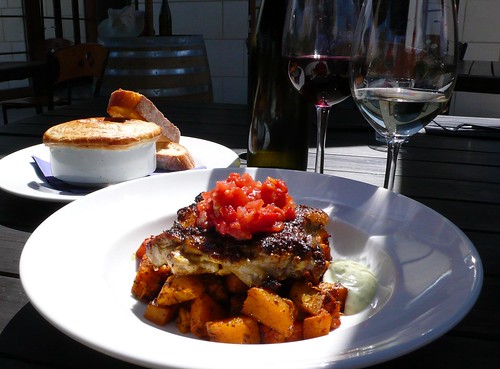
Moroccan chicken leg and Beef Bourguone Pie at Alana Estate.
BTW, we stayed at Martinborough Village Camping (www.martinboroughcamping.com), which was fantastic. Though it was not beachside, the grounds were in a beautiful rural setting, and the place was super clean and well kept.
Wellington
The next day, we headed for New Zealand’s capital city of Wellington. Wellington is a super compact little city (they advertise that you can walk from one end of the CBD—Central Business District—to the other in 20 minutes), and it is known for having a thriving arts culture. As you can see, they really do pack those buildings in there:
Our first day in the big city, we checked out Te Papa museum (www.tepapa.govt.nz/), which is a museum about the history, art, and culture of New Zealand. The exhibits and signage are all in English as well as Maori, which I thought was really cool. The art floor is really well curated, and I loved seeing historical colonial vs. Maori art and how each influence the other. The interesting thing was that colonial art from New Zealand was executed in pretty much the same way as it was in Europe (just with a different landscape), whereas Maori art immediately began taking on some European flavor. There was some really interesting modern art in the museum as well.
We also really enjoyed the floor with native Maori art. The photo below was taken in a reproduction of a Maori hut:
The city of Wellington is really cool. We walked up and down Cuba Street, which is a long street full of vintage shops, design stores, and boutiques full of refashioned clothes—very similar to the Haight. I LOVED this street, though it was a bit torturous, as there were tons of cute clothes and design-y type curios but I couldn’t buy anything. In particular, I loved Iko Iko (cute design store), Hunters & Collectors (amazing vintage shop), Madame Fancy Pants (all handmade goods), and Frutti (really amazing refashioned clothes).
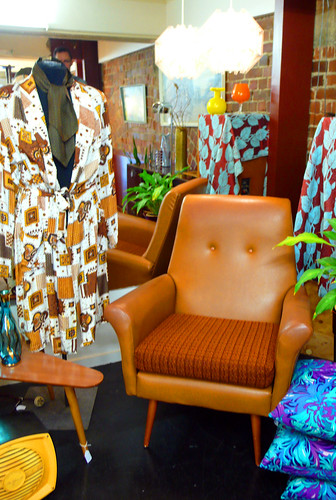
A vignette from Hunters & Collectors, a vintage shop on Cuba Street in Wellington.
The coolest part about this cool city was its proximity to an amazing coastline. Jeremy and I drove along the shore out of the city, along several different bays. When we got to the end of the road, there was a large park with hiking trails and an incredible rocky shore. Jeremy and I kept saying that if Wellington was in California, a gorgeous place this close to the city would be overrun with people (on a Sunday, no less!). But the beach was practically empty. Jeremy went for a run down one of the trails and I hung out, checking out the tidepools.
We adore Wellington and of all the places we’ve been to in New Zealand so far, this is the one place we could see ourselves living. Hmm…maybe when we retire? ![]()
